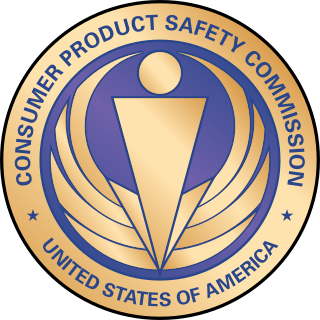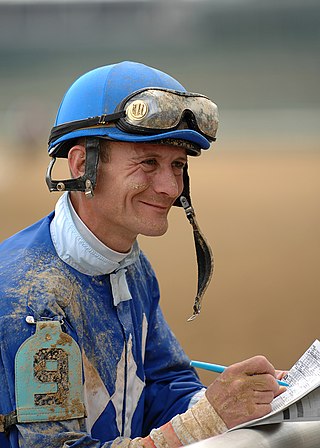
A child harness is a safety device worn by children when walking with a parent or carer. Child harnesses are most commonly used with toddlers and children of preschool age, though they may also be used with older children, especially if they have special supervisory needs such as ADHD or autism. Various types exist, though all are worn by the child and have a lead (tether) or rein which is held by a parent or caregiver. As child harness designs and purposes have evolved with cultural norms and parenting techniques, they have become subject to common debate.

The United States Consumer Product Safety Commission is an independent agency of the United States government. The CPSC seeks to promote the safety of consumer products by addressing "unreasonable risks" of injury ; developing uniform safety standards ; and conducting research into product-related illness and injury. In part due to its small size, the CPSC attempts to coordinate with outside parties—including companies and consumer advocates—to leverage resources and expertise to achieve outcomes that advance consumer safety. The agency was created in 1972 through the Consumer Product Safety Act. The agency reports to Congress and the President; it is not part of any other department or agency in the federal government. The CPSC has five commissioners, who are nominated by the president and confirmed by the Senate for staggered seven-year terms. Historically, the commission was often run by three commissioners or fewer. Since 2009, however, the agency has generally been led by five commissioners, one of whom serves as chairman. The commissioners set policy for the CPSC. The CPSC is headquartered in Bethesda, Maryland.

The presence of the logo on commercial products indicates that the manufacturer or importer affirms the goods' conformity with European health, safety, and environmental protection standards. It is not a quality indicator or a certification mark. The CE marking is required for goods sold in the European Economic Area (EEA); goods sold elsewhere may also carry the mark.

The Europlug is a flat, two-pole, round-pin domestic AC power plug, rated for voltages up to 250 V and currents up to 2.5 A. It is a compromise design intended to connect low-power Class II appliances safely to the many different forms of round-pin domestic power socket used across Europe. However, it is not compatible with the rectangular-pin BS 1363 sockets found in Cyprus, Gibraltar, Singapore, Malaysia, United Arab Emirates, Hong Kong, Ireland, Malta and the United Kingdom.

An infant bed is a small bed especially for infants and very young children. Infant beds are a historically recent development intended to contain a child capable of standing. The cage-like design of infant beds restricts the child to the bed. Between one and two years of age, children are able to climb out and are moved to a toddler bed to prevent an injurious fall while escaping the bed.

Fireworks in England, Scotland and Wales are governed primarily by the Fireworks Regulations 2004, the Pyrotechnic Articles (Safety) Regulations 2015, and British Standards BS 7114 until 4/7/17 and BS-EN 15947-2015. In Northern Ireland, fireworks are governed by The Pyrotechnic Articles (Safety) Regulations 2015, and Explosives (Fireworks) Regulations (NI) 2002.
The Toy Retailers Association is a trade association that represents its members in the UK & Ireland. It promotes the role of the toy retailer and the value of toys to the consumer. It represents about 75% of the toy trade. It is based in Bodmin, Cornwall.

The Kitemark is a UK product and service quality trade mark which is owned and operated by the British Standards Institution.

An equestrian helmet is a form of protective headgear worn when riding horses. This type of helmet is specially designed to protect the rider's head in the event of falls from a horse, especially from striking a hard object while falling or being accidentally struck in the head by a horse's hoof.

Toy safety is the practice of ensuring that toys, especially those made for children, are safe, usually through the application of set safety standards. In many countries, commercial toys must be able to pass safety tests in order to be sold. In the U.S., some toys must meet national standards, while other toys may not have to meet a defined safety standard. In countries where standards exist, they exist in order to prevent accidents, but there have still been some high-profile product recalls after such problems have occurred. The danger is often not due to faulty design; usage and chance both play a role in injury and death incidents as well.

The British Standards Institution (BSI) is the national standards body of the United Kingdom. BSI produces technical standards on a wide range of products and services and also supplies certification and standards-related services to businesses.

European standard EN 71 specifies safety requirements for toys. Compliance with the standard is legally required for all toys sold in the European Union.

The Consumer Product Safety Improvement Act (CPSIA) of 2008 is a United States law signed on August 14, 2008 by President George W. Bush. The legislative bill was known as HR 4040, sponsored by Congressman Bobby Rush (D-Ill.). On December 19, 2007, the U.S. House approved the bill 407-0. On March 6, 2008, the U.S. Senate approved the bill 79-13. The law—public law 110-314—increases the budget of the Consumer Product Safety Commission (CPSC), imposes new testing and documentation requirements, and sets new acceptable levels of several substances. It imposes new requirements on manufacturers of apparel, shoes, personal care products, accessories and jewelry, home furnishings, bedding, toys, electronics and video games, books, school supplies, educational materials and science kits. The Act also increases fines and specifies jail time for some violations.

The Bureau of Indian Standards (BIS) is the National Standards Body of India under Department of Consumer affairs, Ministry of Consumer Affairs, Food & Public Distribution, Government of India. It is established by the Bureau of Indian Standards Act, 2016 which came into effect on 12 October 2017. The Minister in charge of the Ministry or Department having administrative control of the BIS is the ex-officio President of the BIS. BIS has 500 plus scientific officers working as Certification Officers, Member secretaries of technical committees and lab OIC's.

Diving equipment is equipment used by underwater divers to make diving activities possible, easier, safer and/or more comfortable. This may be equipment primarily intended for this purpose, or equipment intended for other purposes which is found to be suitable for diving use.
The United Kingdom Accreditation Service (UKAS) is the sole national accreditation body recognised by the British government to assess the competence of organisations that provide certification, testing, inspection and calibration services. It evaluates these conformity assessment bodies and then accredits them where they are found to meet relevant internationally specified standards.
The Global Food Safety Initiative (GFSI) is a private organization working as a "coalition of action" from the Consumer Goods Forum (CGF), bringing together retailers and brand owners (manufacturers) from across the CGF membership, operating under multistakeholder governance, with the objective to create "an extended food safety community to oversee food safety standards for businesses and help provide access to safe food for people everywhere". GFSI's work in benchmarking and harmonisation aims to foster mutual acceptance of GFSI-recognized certification programmes across the industry, with the ambition to enable a "once certified, accepted everywhere" approach.

CEBEC is a private Belgian rating label for the quality assurance of electrical appliances. Use of this label indicates that a piece of equipment conforms to European safety standards. The label is issued by SGS-CEBEC, now part of the SGS group. CEBEC has its own electrical testing laboratory located in Brussels. It is an approved laboratory for the purpose of certifications granted by SGS.

SHARP is a British government quality ratings scheme for motorcycle helmets, established in 2007, with the objective of improving motorcycle safety on UK roads.

Plugs and sockets for electrical appliances not hardwired to mains electricity originated in the United Kingdom in the 1870s and were initially two-pin designs. These were usually sold as a mating pair, but gradually de facto and then official standards arose to enable the interchange of compatible devices. British standards have proliferated throughout large parts of the former British Empire.

















